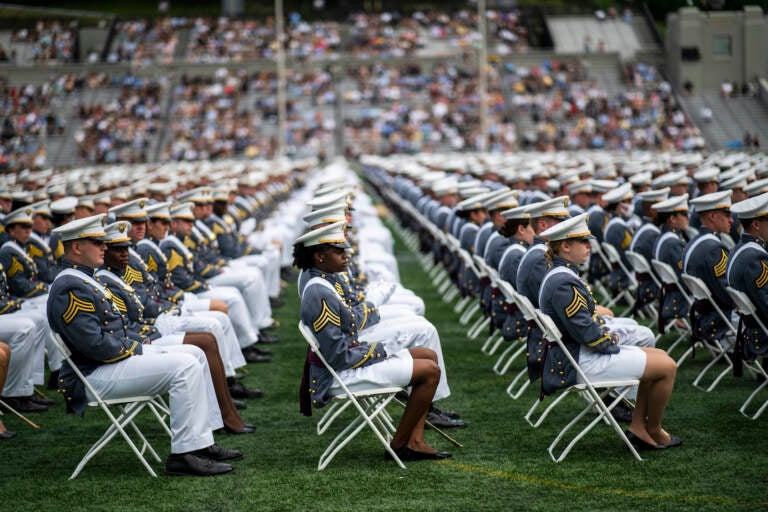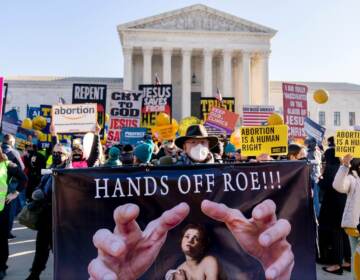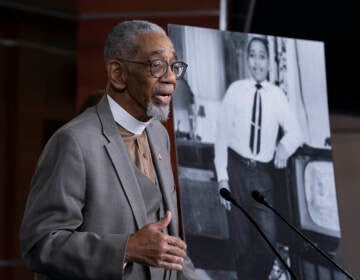‘We just feel it’: Racism plagues U.S. military academies
Beyond blanket anti-discrimination policies, these federally funded institutions volunteer little about how they screen for extremist or hateful behavior.

United States Military Academy graduating cadets during their graduation ceremony of the U.S. Military Academy class 2021 at Michie Stadium on Saturday, May 22, 2021, in West Point, N.Y. (AP Photo/Eduardo Munoz Alvarez)
Eight years after he graduated from the U.S. Military Academy at West Point, Geoffrey Easterling remains astonished by the Confederate history still memorialized on the storied academy’s campus – the six-foot-tall painting of Confederate Gen. Robert E. Lee in the library, the barracks dormitory named for Lee and the Lee Gate on Lee Road.
As a Black student at the Army academy, he remembers feeling “devastated” when a classmate pointed out the slave also depicted in the life-size Lee painting. “How did the only Black person who got on a wall in this entire humongous school — how is it a slave?” he recalls thinking.
As a diversity admissions officer, he later traveled the country recruiting students to West Point from underrepresented communities. “It was so hard to tell people like, ‘Yeah, you can trust the military,’ and then their kids Google and go ‘Why is there a barracks named after Lee?’” he said.
The nation’s military academies provide a key pipeline into the leadership of the armed services and, for the better part of the last decade, they have welcomed more racially diverse students each year. But beyond blanket anti-discrimination policies, these federally funded institutions volunteer little about how they screen for extremist or hateful behavior, or address the racial slights that some graduates of color say they faced daily.
In an Associated Press story earlier this year, current and former enlistees and officers in nearly every branch of the armed services described a deep-rooted culture of racism and discrimination that stubbornly festers, despite repeated efforts to eradicate it.
Less attention has been paid to the premiere institutions that produce a significant portion of the services’ officer corps – the academies of the U.S. Army, the U.S. Navy, the U.S. Air Force, the U.S. Coast Guard and U.S. Merchant Marine.
Some graduates of color from the nation’s top military schools who endured what they described as a hostile environment are left questioning the military maxim that all service members wearing the same uniform are equal.
That includes Carlton Shelley II, who was recruited to play football for West Point from his Sarasota, Florida, high school and entered the academy in 2009. On the field, he described the team as “a brotherhood,” where his skin color never impacted how he was treated. But off the field, he said, he and other Black classmates too often were treated like the stereotype of the angry Black man – an experience that brought him to tears at the time.
“I was repeatedly in trouble or being corrected for infractions that were not actually infractions,” he said. “It was a very deliberate choice to dig and to push on certain individuals compared with other cadets — white cadets.”
Xavier Bruce, who graduated from the Air Force Academy in 1999 and rose to the rank of lieutenant colonel during his 24 years of duty, said that for him, it was the ongoing slights directed at him as a Black man, rather than openly racist behavior, that cut deep.
“We just feel it, we feel the energy behind it, and it just eats us away,” he said.
Some students of color have spotlighted what they see as systemic racism and discrimination at the academies by creating Instagram accounts — “ Black at West Point,” “ Black at USAFA ” and “ Black at USNA ” — to relate their personal experiences.
“I was walking with a classmate and we were both speaking Spanish when a white, male upperclassman turned around and said ‘Speak English, this is America,’” a 2020 Air Force Academy graduate wrote in one post.
In response to the AP’s findings, a spokesman for the Department of Defense, Maj. Charlie Dietz, said the service academies make it a policy to offer equal opportunities regardless of race, color, national origin, religion, sex, gender identity or sexual orientation. He said the DOD formed a special team in April to advance progress on diversity, equity and inclusion across the entire department, including the academies.
West Point did not respond to repeated requests for comment, beyond reiterating the importance of diversity to its admissions process and to preparing cadets for leadership.
Following the murder of George Floyd in 2020, which sparked protests around the globe, a group of prominent West Point alums had released a 40-page letter urging the academy to address “major failures” in combatting intolerance and racism. “Though we are deeply disturbed, we hold fast to the hope that our Alma Mater will take the necessary steps to champion the values it espouses,” the letter said.
An appendix offered anonymous testimonials gathered last year from West Point cadets about incidents they said went unaddressed by school officials. “I had a racist roommate that would call me the n-word and spit on me,” one cadet wrote. “I told the 4th Regimental Tactical Officer about it, and they did nothing.”
Shelley acknowledges West Point has become more racially diverse, but said the academy has significant work to do to retain and support students of color. In his class, he estimated about 35 Black students graduated — “some crazy low number,” he said. “And we started with a lot more.”
In a sense, the tributes to Lee that still dot the West Point campus illustrate the academy’s dichotomy: Cadets studying military history are taught that Confederate soldiers were no heroes, yet the references to Lee — a West Point graduate who later became the academy’s superintendent — remain.
The latest annual defense spending bill mandated that the Defense Department survey all its military properties for references or symbols that potentially commemorate the Confederacy, including at West Point, which the commission overseeing the work picked as its first site to visit earlier this year. But the deadline to act on any recommendations is still more than two years away.
___
The U.S. armed forces were segregated until the mid-1950s, when an influx of fighters were needed for the Korean War. Now, the collected services applaud themselves for 200 years as “the greatest military force in history,” attracting men and women who represent all creeds, religions, races, ethnicities and sexual orientations.
At the academies, integration happened much earlier, following the abolition of slavery. During Black History Month at West Point, honor is paid to Henry O. Flipper, a formerly enslaved man who became the academy’s first Black graduate in 1877. But the West Point that Flipper attended was rife with prejudice: His white classmates and professors refused to acknowledge his presence.
Today, the academies are a growing pathway to officer status for Black cadets, 2019 data from the Under Secretary of Defense shows, with about 13% of Black active-duty officers commissioned through the five institutions, compared to 19% of white active-duty officers.
Most students who enroll — about 60-70% — are nominated by U.S. senators or representatives from their home states as part of a system created in the 1840s to build a politically and geographically diverse officer corps. But today, the changed demographics of the U.S. mean the system gives disproportionate influence to rural congressional districts that tend to be whiter, the AP found.
Only 6% of nominations to the Army, Air Force and Naval academies made by the current members of Congress went to Black candidates, even though 15% of the population aged 18 to 24 is Black, according to a report on the service academies released in March by the Connecticut Veterans’ Legal Center. Eight percent of congressional nominations went to Hispanic students, though they make up 22% of young adults, the report said.
The diversity of nominations has improved slightly in the past 25 years, but the report noted that 49 Congress members did not nominate a single Black student during their time in office and 31 nominated no Hispanic candidates.
In Texas, nominations to the service academics from senators Ted Cruz and John Cornyn included 23% and 20% people of color, respectively — among the lowest levels in the Senate compared to the demographics of their state, where more than 60% of young adults are Black, Asian American, Hispanic or Latino.
Cruz’s press secretary, Dave Vasquez, said the senator rejects that race should be factored in when selecting academy nominees and that names, race and other personal information are all removed before an external review board considers applications to Cruz’s office, selecting candidates “on objective merits such as SAT/ACT scores, GPA, and community-service involvement.” Cornyn’s office did not respond to a request for comment.
Curtis Harris said he was awarded one of just three nominations to West Point out of more than 300 applications to his congressman. He graduated in 1978 and became the first in his family to rise to the officer ranks, initially becoming a platoon leader overseeing 35 people and equipment worth millions of dollars at the age of just 21. His uncles had enlisted in the Army and his stepfather was a Navy cook, but they had few options for advancement as Black servicemen, he said.
West Point remains a point of pride for Harris: He hasn’t missed an Army-Navy football game in 40 years, and he helps review applications for nominations for U.S. Rep. Adriano Espaillat of New York. He also visits high schools and junior high schools to encourage candidates of diverse backgrounds to apply.
In a society where opportunity is not given out equally, Harris said, the academy provides the “ammunition” to be successful. Yet diversifying West Point is “not going to happen by itself,” he said. “I just think that particularly people of color should know that this opportunity exists.”
The Naval, Air Force, Merchant Marine and Coast Guard academies have generally become more diverse over the past two decades, according to data supplied by the four schools after the AP asked for 20 years of student body demographic data. West Point did not provide historical records, but Col. Deborah McDonald, the academy’s admissions director, said it is welcoming more and more diverse students, with 37% of the class of 2024 identifying as nonwhite. A decade ago, that proportion was more like 25%, she said.
Non-white racial groups did not see appreciable changes at some academies. For instance, while the number of Hispanic cadets increased in the past two decades at the Coast Guard and Naval academies, Black cadets showed no noticeable increase during that time. In the class of 2000, there were 73 Black midshipmen in the Naval Academy — and just 77 in 2020. At the Coast Guard Academy, there were 15 Black cadets in the 2001 class. And in 2021? Merely 16.
According to the data provided to the AP, graduation rates between racial groups at the Naval and Coast Guard academies continued to show gaps. At the Naval Academy, for example, Black midshipmen still had the lowest graduation rate of any racial group at 74%, compared to the 2020 school-wide rate of 87%. And the Black graduation rate of 65% at the Coast Guard Academy between 2011 and 2020 lagged about 20 percentage points behind other racial groups.
Only data from the Navy and Coast Guard was complete and detailed enough to look at graduate rate trends by race.
Two of the five academies — West Point and the Air Force Academy — now have their first Black leaders. But Easterling, the West Point graduate, noted that the faculty there remains mostly white, meaning that students who “don’t see themselves, and don’t want to stay” can find it hard to ask for help.

Greg Elliott said he often found himself in trouble as a midshipman at the Merchant Marine Academy and was asked to leave without graduating. He doesn’t blame the academy for his mistakes and he said he never faced overt racism, but he wonders if a more diverse faculty and student body could have changed his course by making him feel he belonged.
He remembers a fellow Black alum telling him to just plow through with his head down and realize the academy was “a terrible place to be at, but it’s a great place to be from.”
Both Easterling and Shelley said they also saw signs of extremism during their time in the Army — for Easterling, it was a member of his unit wearing a symbol for the Three Percenters, an anti-government paramilitary group. Both said the academies — and the military — need stronger guidelines for recognizing and confronting language and symbols that suggest an extremist path.
Kyle Bibby, a Naval Academy graduate who served for six years in the Marine Corps as an infantry officer, said those who characterize white supremacism only as extreme behavior miss the insidious damage that casual racism and discriminatory attitudes can inflict.
“We view white supremacy as like, you know, somebody’s got the cross in the truck and they’re rolling to your crib to go burn it,” said Bibby, who co-founded the Black Veterans Project, which advocates for racial justice in the armed services. But the cuts are much more subtle, he said.
At the Naval Academy, he said he once was told that he was “the whitest Black guy” one of his white classmates had ever met because of his skill at trivia games. Another white classmate, unaware Bibby was in earshot, remarked that he didn’t care that his sister was dating a Filipino guy but would “kill” her if she dated a Black guy.
Timothy Berry, a former Army field artillery officer who graduated from West Point in 2013 and served as class president, said he never felt comfortable reporting racist incidents while at the academy, fearing it would draw unwanted scrutiny to him not being a “perfect cadet,” however minor his shortcomings might be.
An inspector general’s report last year found the Coast Guard Academy had mishandled nearly a dozen race-based harassment allegations between 2013 and 2018 and also noted that harassment was underreported in part because of “concerns about negative consequences.”
Lt. Cmdr. Kimberly Young-McLear, a Black woman who taught at the academy from 2014 to 2019, said she herself faced years of harassment and retaliation on campus, which she has detailed in congressional testimony. She said she continues to hear from cadets, faculty and staff at the academy who are afraid to speak out about their negative treatment.
“They truly are reaching out because they don’t have anywhere else to turn,” she said. “This isn’t about cadets just whining and complaining. They’re going against a very powerful institution.”
___
Although the academies play a big role in the diversity of military leadership, some have argued that the pipeline begins even earlier, at the high school level.
The Department of Defense sponsors Junior ROTC programs at high schools around the country where students can learn the values of the armed services, run drills and wear the uniforms. According to a 2017 study sponsored by the Secretary of Defense, the programs are often located at high schools with larger-than-average populations of students of color.
Though it may not be an official recruitment program, Junior ROTC promotes the military branches as a pathway to excellence.
Cadet handbooks for the Navy, Army, Air Force and Marine Corps all stipulate non-discrimination policies with regard to race and gender, and emphasize treating everyone with dignity and respect.
But former Junior ROTC instructor Cardelle Anthony Hopkins said little was done after one of his students at Lake Brantley High School in Florida alerted him to social media posts by her fellow cadets making racist comments about Hopkins, a retired Black master sergeant. The language was crude and threatening: One comment said he needed to be “tar and feathered.” “No n—— in my corps,” read another.
The students also created a fake Instagram account impersonating Hopkins that included posts making fun of cadets. And ahead of Martin Luther King Jr. Day, someone posted a sign on his classroom door reading “Blood and Soil,” a white supremacist slogan.
“I was so intimidated even walking to my car. I’m thinking, I’m a grown man … I’ve never been this terrified,” Hopkins said. “In my entire 23 years in the military, I had never been called a n—– ever. And here I am being called that by my students.”
Near the end of 2019, Hopkins said he noticed a change in the types of students enrolling in the JROTC program. In one of his freshman classrooms, for instance, every white student wrote a message in support of President Donald Trump while working on an art project to decorate ceiling tiles, he said.
“I could see that these students were a different breed,” he said, noting that their behavior prompted the parents of one of his Black students to remove their daughter from the program.
Hopkins said he complained about the harassment but that it wasn’t until other students went directly to Lake Brantley Principal Brian Blasewitz saying they knew who was responsible that administration officials acted to track down the two main students involved.
Hopkins said the students eventually received four-day suspensions. Blasewitz told the AP that the incidents were taken seriously, but would not disclose any disciplinary measures.
Hopkins contacted the officer then heading the Air Force Junior ROTC, who he said expressed sympathy but took no other action, other than saying Hopkins could request a transfer to a new school.
“We have roughly 120,000 cadets in Air Force JROTC alone,” Hopkins said. “This one colonel sitting in his office has the ability to put out a message to every last Air Force Junior ROTC school if he wants to that says ‘We will not tolerate anything like this’ and really get on top of this.’”
In an email to the AP, the current Air Force Junior ROTC director, Col. Johnny R. McGonigal, said the responsibility for addressing the incidents fell on the high school, writing that “the instructors are employees of the school and the school district is responsible for investigating and resolving disciplinary matters such as this one.”
Feeling defeated and isolated, Hopkins said his father — a veteran and also a former JROTC instructor — advised him to leave, telling him “there’s no reason to put yourself through this.”
After briefly holding the same job at another school, he stepped away from JROTC altogether and abandoned a lawsuit he had filed with the Equal Employment Opportunity Commission. He’s joining a Tampa, Florida, high school as a teacher’s assistant — a job that doesn’t capitalize on his more than 20 years of military experience.
Hopkins said his ordeal leaves him unsettled about the future of the JROTC and, ultimately, the U.S. military.
“It just feels like a breeding ground for hatred,” he said of JROTC. “And it’s not being checked.”

Saturdays just got more interesting.
WHYY is your source for fact-based, in-depth journalism and information. As a nonprofit organization, we rely on financial support from readers like you. Please give today.






